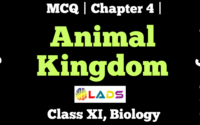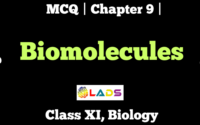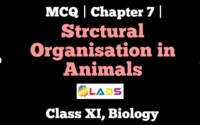MCQ of Cell The Unit of Life | Chapter 8 | Class 11 | Biology | CBSE
MCQ Of Cell The Unit of Life, Chapter 8, Class 11, Biology
Question 1: The most likely method used to determine the ultrastructure of a cell organelle is
- Autoradiography
- Microdissection
- Electron microscopy
- Phase contrast microscopy
Answer : C (Electron microscopy)
Question 2: Cell theory was formulated by
- Schleiden and Schwann
- Robert Hooke
- Leeuwenhoek
- Marcello Malpighi
Answer : A (Schleiden and Schwann)
Question 3: _______ are an exception to cell theory.
- Bacteria
- Fungi
- Viruses
- Lichens
Answer : C (Viruses)
Question 4: Who proposed a modification in the cell theory?
- Schleiden and Schwann
- Rudolf Virchow
- Robert Hooke
- Marcello Malpighi
Answer : B (Rudolf Virchow)
Question 5: What is true about genetic material of a prokaryotic
- Lacks histones
- Not enveloped by nuclear membrane
- Composed of a single circular DNA molecule for
- All of these
Answer : D (All of these)
Question 6: Prokaryotic cells are generally _______ and multiply ______ than the eukaryotic cells.
- Smaller, slower
- Larger, slower
- Smaller, faster
- Larger, faster
Answer : C (Smaller, faster)
Question 7: Glycocalyx (mucilage sheath) of a bacterial cell may occur in the form of a loose sheath called ______ or it may be thick and tough called ______.
- Capsule, slime layer
- Slime layer, capsule
- Mesosome, capsule
- Mesosome, slime layer
Answer : B (Slime layer, capsule)
Question 8: _______ are self replicating, extra chromosomal segments of double stranded circular and naked DNA, present in a bacterial cell.
- Plasmids
- Nucleoid
- Mesosomes
- Bacteriophages
Answer : A (Plasmids)
Question 9: The type of ribosomes found in prokaryotes is
- 80S type
- 70S type
- 30S type
- 50S type
Answer : B (70S type)
Question 10: If you remove the fimbriae from the bacterial cell, which of the following would you expect to happen?
- The bacteria could no longer swim
- The bacteria would not adhere to the host tissue
- Transportation of molecules across the membrane would stop
- The shape of bacteria would change
Answer : B (The bacteria would not adhere to the host tissue)
Question 11: Plant cells differ from animal cells in having
- Cell wall
- Plastids
- A large central vacuole
- All of these
Answer : D (All of these)
You may also read MCQ of The Living World, MCQ of Biological Classification, MCQ of Plant Kingdom, MCQ of Animal Kingdom, MCQ of Morphology of Flowering Plants, MCQ of Structural Organization in Animals, MCQ of Biomolecules for better understanding of the chapters.
Question 12: Which one is the mis-matched pair?
- Largest isolated single cell – Egg of an ostrich
- Golgi apparatus – Discovered by Altman
- Mitochondria – Name was given by Benda
- Lysosomes – Discovered by de Duve
Answer : B (Golgi apparatus – Discovered by Altman)
Question 13: Polyribosomes are aggregation of
- Ribosomes and rRNA
- Peroxisomes
- Several ribosomes held together by a string of mRNA
- rRNA
Answer : C (Several ribosomes held together by a string of mRNA)
Question 14: Which of these is not correct regarding ribosomes?
- Non – membrane bound
- Present in the cytoplasm and on RER
- Absent in chloroplast and mitochondria
- Take part in protein synthesis
Answer : C (Absent in chloroplast and mitochondria)
Question 15: Which of the following organelles is not included in endomembrane system?
- Golgi complex
- Peroxisomes
- Lysosomes
- Vacuoles
Answer : B (Peroxisomes)
Question 16: Cell recognition and adhesion are facilitated by components of plasma membrane. These components are generally
- Protein molecules alone
- Lipids alone
- Both lipids and proteins
- Glycolipids and glycoproteins
Answer : D (Glycolipids and glycoproteins)
Question 17: The function of intracellular membrane is not to
- Establish a number of compartments within the cell
- Provide for the neat spatial organization of enzymes and pigments
- Keep the cell rigidity so that it does not collapse
- Provide a system of channel for the distribution of nutrients within the cell.
Answer : C (Keep the cell rigidity so that it does not collapse)
Question 18: A phospholipid molecule is amphipathic and produces two layers coming in contact with H20. The head of phospholipid molecule is
- At an angle of 40°
- At the outer surface
- On the inner side
- Embedded in protein molecules
Answer : B (At the outer surface)
Question 19: Lysosomes are _______ vesicular structures formed by the process of packaging in the ________ .
- Membrane bound, Golgi apparatus
- Non – membrane bound, Golgi apparatus
- Membrane bound, ER
- Non – membrane bound, ER
Answer : A (Membrane bound, Golgi apparatus)
Question 20: Which of these is not a function of Golgi apparatus?
- Site of synthesis of glycoproteins and glycolipids
- Secretion
- Membrane transformation
- Site of protein synthesis
Answer : D (Site of protein synthesis)
Question 21: Smooth endoplasmic reticulum is well developed in the cells which synthesize
- Steroids
- Proteins
- Carbohydrates
- All of these
Answer : A (steroids)
Question 22: In which of the following part of mitochondria succinic dehydrogenase enzyme is located ?
- Perimitochondrial space
- Outer membrane
- Matrix
- Inner membrane
Answer : D (Inner membrane)
Question 23: Which organelle helps in the synthesis of lipids, cholesterol,steroids and visual pigments in epithelial cells of retina ?
- Golgi bodies
- RER
- SER
- Mitochondria
Answer : C (SER)
Question 24: Cell organelle extracted from endosperm of germinating castor beans are
- Glyoxysomes
- Peroxisomes
- Mitochondria
- None of these
Answer : A (Glyoxysomes)
Question 25: As release hydrolase that digest old and damaged cells the term suicide bags is aptly used by cell biologists for
- Golgi bodies
- Lysosomes
- Glyoxysomes
- Peroxisomes
Answer : B (Lysosomes)
Question 26: Select the incorrect pair.
- Cell wall – Structural support
- Central vacuole – Storage
- Amyloplast – Starch storage
- Plasmodesmata – Protection
Answer : D (Plasmodesmata – Protection)
Question 27: Ribosomes are synthesized in
- Nucleolus
- Cytoplasm
- Mitochondria
- Golgi complex
Answer : A (Nucleolus)
Question 28: Match Column – I with Column – II and select the correct option from the codes given below.
| Column – I | Column – II |
| a. RER | (i) Intracellular and extracellular digestion |
| b. SER | (ii) Lipid synthesis |
| c. Golgi complex | (iii) Protein synthesis and secretion |
| d. Lysosomes | (iv) Moves materials out of the cell |
- a – (iii), b – (ii), c – (iv), d – (i)
- a – (ii), b – (iii), c – (iv), d – (i)
- a – (i), b – (iii), c – (ii), d – (iv)
- a – (iv), b – (ii), c – (iii), d – (i)
Answer : A (a – (iii), b – (ii), c – (iv), d – (i))
Question 29: _______ are the single membrane bound organelle.
- Sphaerosome
- Lysosome
- Glyoxysome
- All of these
Answer : D (All of these)
Question 30: Non – membrane bound cell organelle is
- Ribosomes
- Centrioles
- Nucleolus
- All of these
Answer : D (All of these)
Question 31: Extranuclear inheritance is due to the presence of genes in
- Mitochondria and chloroplasts
- Nucleus and mitochondria
- Nucleus and chloroplasts
- Endoplasmic reticulum and mitochondria
Answer : A (Mitochondria and chloroplasts)
Question 32: Lysosomes are the reserve years (store houses) of
- Hydrolytic enzymes
- Oxidative enzymes
- Secretory glycoproteins
- RNA and proteins
Answer : A (Hydrolytic enzymes)
Question 33: Bright colour of petals, is due to the presence of
- Chloroplast
- Anthocyanin
- Chromoplast
- Leucoplast
Answer : B (Anthocyanin)
Question 34: Cell organelle responsible for autolysis is
- Dictyosome
- Lysosome
- Peroxisome
- Glyoxysome
Answer : B (Lysosome)
Question 35: Cells which are secretory in function have abundant
- Lysosomes
- Endoplasmic reticulum
- Dictyosomes
- Osteosomes
Answer : C (Dictyosomes)
Question 36: Who coined the term mitochondria?
- Altman
- Benda
- de Duve
- C. Golgi
Answer : B (Benda)
Question 37: Study the following statements regarding mitochondria and select the correct ones.
(i) These are the sites of aerobic respiration.
(ii) Matrix contains single circular ds DNA molecule, a few RNA molecules, 70S ribosomes.
(iii) Mitochondria divide by fission.
(iv) Mitochondria are fully – autonomous
- (i) and (ii)
- (iii) and (iv)
- (i), (ii) and (iii)
- (i), (ii), (iii) and (iv)
Answer : C ((i), (ii) and (iii))
Question 38: Ribosomes of the cytoplasm, chloroplast and mitochondrion are respectively
- 80S, 80S and 705
- 80S, 70S and 70S
- 70S in all
- 80S in all
Answer : B (80S, 70S and 70S)
Question 39: _______ are granular structures first observed under electron microscope as dense particles by _______ .
- Ribosomes, George Palade
- Ribosomes, Perner
- Lysosomes, de Duve
- Peroxisomes, de Duve
Answer : A (Ribosomes, George Palade)
Question 40: Arrangement of microtubules in a flagellum and centriole is respectively
- 9 + 2 and 9 + 1
- 9 + 1 and 9 + 0
- 9 + 0 and 9 + 2
- 9 + 2 and 9 + 0
Answer : D (9 + 2 and 9 + 0)
Question 41: Which of the following observations most strongly support – the view that mitochondria contain electron transport enzymes aggregated into compact association?
- Mitochondria have a highly folded inner wall.
- Disruption of mitochondria yields membrane fragments ,
which are able to synthesise ATP. - A contractile protein capable of utilising ATP has been obtained from mitochondria.
- Mitochondria in animal embryos have a tendency to concentrate in cells, which are to become locomotory structures.
Answer : B (Disruption of mitochondria yields membrane fragments ,which are able to synthesise ATP)
Question 42: Ribosomes are composed of
- RNA only
- Proteins only
- RNA and proteins
- RNA, Proteins and DNA
Answer : C (RNA and proteins)
Question 43: These are the densely stained reticular structures present near the nucleus, consisting of many flat, disc shaped cisternae of 0.5 – 1.0 µm diameter. These are
- Chloroplasts
- Endoplasmic reticulum
- Mitochondria
- Golgi apparatus
Answer : D (Golgi apparatus)
Question 44: Lipids are arranged within the membrane with
- Polar heads toward inner side and the hydrophobic tails toward outerside
- Both heads and tails toward outerside
- Heads toward outerside and tail towards inside
- Both heads and tails toward innerside.
Answer : C (Heads toward outerside and tail towards inside)
Question 45: Select the incorrect statement regarding the plasma membrane.
- Ratio of proteins and lipids varies considerably in different cell types.
- 52% proteins and 40% lipids constitute the membrane of human RBC.
- Arrangement of proteins (P) and Lipids (L) is L – P – P – L.
- Head of lipid is hydrophilic.
Answer : C (Arrangement of proteins (P) and Lipids (L) is L – P – P – L.)
Question 46: The latest model of cell membrane is the
- Unit membrane model
- Fluid mosaic model
- Danielli and Davson’s model
- Robertson’s model
Answer : B (Fluid mosaic model)
Question 47: The fluid mosaic model explains which aspects of membrane?
- Only structural aspects
- Only functional aspects
- Both structural and functional aspects
- Only fluidity of membrane
Answer : C (Both structural and functional aspects)
Question 48: Integral cell membrane proteins
- Are partially embedded in lipid layers
- Are completely embedded in lipid layers
- Show lateral but not vertical movements within bilayer of lipid
- All of these
Answer : D (All of these)
Question 49: The movement of cilia and flagella is due to the presence of
- Radial spokes
- Central sheath
- Singlet microtubules
- Dyneins
Answer : D (Dyneins)
Question 50: If you remove the cell wall from a plant cell and place it into a drop of water
- The cell would begin to grow
- The cell would shrink
- The cell would burst
- Nothing would happen
Answer : C (The cell would burst)
Question 51: A cell, which is very active in the synthesis and secretion of proteins, would be expected to have
- Equal amount of RER and SER
- More SER than RER
- More RER than SER
- More Golgi bodies and no ER
Answer : C (More RER than SER)
Question 52: Which of the following cell organelles are named after the name of its discoverer?
- ER
- DNA
- Golgi bodies
- Mitochondria
Answer : C (Golgi bodies)
Question 53: Read the given statements regarding a cell organelle. (i) It contains water, sap, excretory products and other unwanted materials.
(ii) It is bounded by a single membrane called tonoplast.
(iii) In plant cells, it can occupy upto 90% of cellular volume.
(iv) Its contents form cell sap.
(v) It maintains turgor pressure.
The above features are attributed to
- Lysosome
- Vacuole
- Peroxisome
- Mitochondrion
Answer : B (Vacuole)
Question 54: Which of the following statements is incorrect?
- Mitochondria, unless specifically stained are not easily visible under the microscope.
- Physiological activity of cells determines the number of mitochondria per cell.
- Mitochondrion, a power house of cell has DNA, RNA, ribosomes and enzymes, so it can survive outside the cell.
- Mitochondria divide by fission
Answer : C (Mitochondrion, a power house of cell has DNA, RNA, ribosomes and enzymes, so it can survive outside the cell)
Question 55: Which of the following is the correct match?
- Amyloplasts – Store carbohydrates
- Elaioplasts – Store fats and oils
- Aleuroplasts – Store proteins
- All of these
Answer : D (All of these)
Question 56: Which group of organelles is involved in synthesis of substances needed by cell?
- Lysosome, vacuole, ribosome
- Vacuole, RER, SER
- Ribosome, RER, SER
- RER, lysosome, vacuole
Answer : C (Ribosome, RER, SER)
Question 57: Dye injected into a cell might be able to enter an adjacent cell through
- Microtubule
- Microfilament
- Plasmodesmata
- Tight junction
Answer : C (Plasmodesmata)
Question 58: The core of a cilium or flagellum composed of microtubules and their associated proteins is called
- Blepharoplast
- Axoneme
- Microfilament
- Tubulin
Answer : B (Axoneme)
Question 59: Centrioles arise from
- Pre – existing centrioles
- de novo
- Nuclear envelope
- Sphaerosome
Answer : A (Pre – existing centrioles)
Question 60: Which of the following statements is incorrect for centrioles?
- Both the centrioles in a centrosome lie perpendicular to each other.
- Central proteinaceous hub is missing in a centriole.
- Each centriole has an organization like that of a cartwheel.
- Centrosome usually contains 2 cylindrical centrioles.
Answer : B (Central proteinaceous hub is missing in a centriole)
Question 61: How does a cell rid itself of defective or malfunctioning organelles?
- They are engulfed by plastids and stored until export from cell is possible.
- Defective parts accumulate until the cell itself dies.
- They are exported by exocytosis.
- Lysosomes assist in the removal of defective organelles by digesting them.
Answer : D (Lysosomes assist in the removal of defective organelles by digesting them)
Question 62: Which of the following statements regarding sphaerosomes is not correct?
- Abundant in the endosperm cells of oil seeds.
- Bounded by a single membrane
- Take part in synthesis and storage of lipids
- In plants they take part in photorespiration
Answer : D (In plants they take part in photorespiration)
Question 63: All plastids have essentially the same structure because
- They have to perform the same function
- They are localised in the aerial parts of plants
- One type of plastids can differentiate into another type of plastids depending upon the cell requirements
- All plastids have to store starch, lipids and proteins.
Answer : C ( One type of plastids can differentiate into another type of plastids depending upon the cell requirements)
Question 64: Which one of these is not correct regarding peroxisomes?
- Single membrane bound organelles
- Perform photorespiration in C3 plants
- Take part in synthesis and storage of lipids
- Protect a cell from the toxic effects of H202
Answer : C (Take part in synthesis and storage of lipids)
Question 65: _______ are the microbodies, which take part in glyoxylate pathway, bounded by a single membrane and are usually present in germinating fatty seeds.
- Glyoxysomes
- Peroxisomes
- Sphaerosomes
- Lysosomes
Answer : A (Glyoxysomes)
Question 66: According to most recent studies each chromosome consists of
- Single double helical DNA which is highly coiled and folded
- Variable number of DNA helices, depending upon the length of chromosome
- Many small DNA helices, which are joined by peptide linkages
- Small DNA helices, wrapped around each other like a rope
Answer : A (Single double helical DNA which is highly coiled and folded)
Question 67: In chloroplasts, chlorophyll is present in the
- Outer membrane
- Inner membrane
- Thylakoids
- Stroma
Answer : C (Thylakoids)
Question 68: Which chemical property is shared by all types of lipids forming the plasma membrane?
- Sugar component
- Glycerol backbone
- Phosphate group
- Hydrophobic region
Answer : D (Hydrophobic region)
Do share the post if you liked the MCQ of Cell. For more updates, keep logging on BrainyLads



